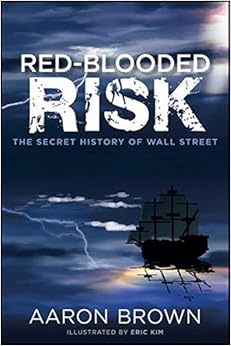
Red-Blooded Risk: The Secret History Of Wall Street Download Free (EPUB, PDF)

An innovative guide that identifies what distinguishes the best financial risk takers from the rest From 1987 to 1992, a small group of Wall Street quants invented an entirely new way of managing risk to maximize success: risk management for risk-takers. This is the secret that lets tiny quantitative edges create hedge fund billionaires, and defines the powerful modern global derivatives economy. The same practical techniques are still used today by risk-takers in finance as well as many other fields. Red-Blooded Risk examines this approach and offers valuable advice for the calculated risk-takers who need precise quantitative guidance that will help separate them from the rest of the pack. While most commentators say that the last financial crisis proved it's time to follow risk-minimizing techniques, they're wrong. The only way to succeed at anything is to manage true risk, which includes the chance of loss. Red-Blooded Risk presents specific, actionable strategies that will allow you to be a practical risk-taker in even the most dynamic markets. Contains a secret history of Wall Street, the parts all the other books leave out Includes an intellectually rigorous narrative addressing what it takes to really make it in any risky activity, on or off Wall Street Addresses essential issues ranging from the way you think about chance to economics, politics, finance, and life Written by Aaron Brown, one of the most calculated and successful risk takers in the world of finance, who was an active participant in the creation of modern risk management and had a front-row seat to the last meltdown Written in an engaging but rigorous style, with no equations Contains illustrations and graphic narrative by renowned manga artist Eric Kim There are people who disapprove of every risk before the fact, but never stop anyone from doing anything dangerous because they want to take credit for any success. The recent financial crisis has swelled their ranks, but in learning how to break free of these people, you'll discover how taking on the right risk can open the door to the most profitable opportunities.

Hardcover: 432 pages
Publisher: Wiley; 1 edition (October 11, 2011)
Language: English
ISBN-10: 1118043863
ISBN-13: 978-1118043868
Product Dimensions: 6.3 x 1.1 x 9.3 inches
Shipping Weight: 3 pounds (View shipping rates and policies)
Average Customer Review: 4.3 out of 5 stars See all reviews (25 customer reviews)
Best Sellers Rank: #263,455 in Books (See Top 100 in Books) #74 in Books > Business & Money > Insurance > Risk Management #667 in Books > Business & Money > Biography & History > Company Profiles #1600 in Books > Business & Money > Finance

I was impressed by the 5 stars of this book and bought it on my kindle. I realized the book is not as great as I have expected for the following reasons:1. Interesting story made boring.The author has many interesting little facts, academic experiment results and logic. I believe they will make him an interesting person to chat with, or an interesting presentation in a conference or seminar. However they become boring in text mainly because of the book's prolixity and disorganized article structure.2. Misleading titles:Both the book title and the chapter titles provide misleading information to what the content will tell you. For the most obvious example, you can hardly expect too much history on the wall-street on the "secret history of wall street". You will expect to be traced back history as far as stone age about how ancient people (and even animals) react to risk. (Probably "the history that made wall-street"?)3. Lengthy introductions before making a point:Whenever the author tried to put forth an idea, the author will trace all the way to its origin, and the origin of the origin. You often find yourself reading something like this: "before we talk about C, let's talk about B first.". Then it will follow "before we talk about B, let's talk about A." The author believe the origin of his knowledge is very important and he would like you to be equaly fascinated by the evolution of his ideas. This is understandable perhaps given his math background as he would just felt inclined to proof every result. However I just find myself lost within the process like I got lost in a math class.
Red-Blooded Risk: The Secret History of Wall Street Red-Blooded American Male: Photographs Bull by the Horns: Fighting to Save Main Street from Wall Street and Wall Street from Itself Blue Blooded: Denim Hunters and Jeans Culture The Feeling of Risk: New Perspectives on Risk Perception (Earthscan Risk in Society) The Wall Street Journal Guide to Understanding Money and Investing, Third Edition (Wall Street Journal Guide to Understanding Money & Investing) The Wall Street Journal Complete Money and Investing Guidebook (The Wall Street Journal Guidebooks) Terror on Wall Street, a Financial Metafiction Novel (Wall Street Series Book 1) Red-eared Slider Turtle. Red-eared Slider Turtle Owners Manual. Red-eared Slider Turtle Pros and Cons, Care, Housing, Diet and Health. Heard on the Street: Quantitative Questions from Wall Street Job Interviews Private Equity at Work: When Wall Street Manages Main Street Top Secret Files: The Civil War: Spies, Secret Missions, and Hidden Facts from the Civil War (Top Secret Files of History) Street Gang: The Complete History of Sesame Street ForeX Trading for Maximum Profit: The Best Kept Secret Off Wall Street Octopus: Sam Israel, the Secret Market, and Wall Street's Wildest Con ISO/IEC 31010:2009, Risk management - Risk assessment techniques Security Risk Management: Building an Information Security Risk Management Program from the Ground Up COSO Enterprise Risk Management: Establishing Effective Governance, Risk, and Compliance (GRC) Processes Global Risk Agility and Decision Making: Organizational Resilience in the Era of Man-Made Risk Advances in Heavy Tailed Risk Modeling: A Handbook of Operational Risk (Wiley Handbooks in Financial Engineering and Econometrics)



